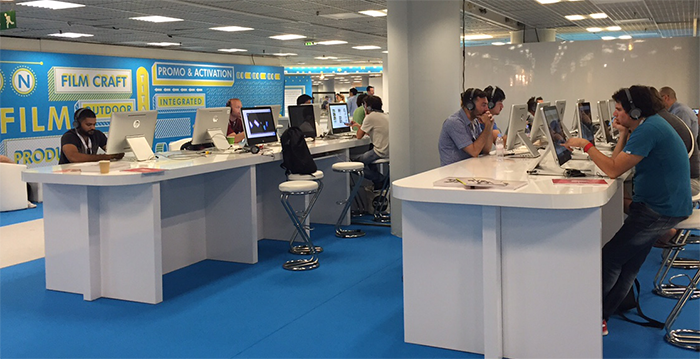Each June, the advertising and media industry gathers up its white linen suits and straw fedoras and heads off to the Cannes Lions International Festival of Creativity for a week of thought leadership, networking, and the occasional glass or two of rosé. Pixability’s executive team had a strong presence at the festival throughout the week.
Although the team didn’t bring back any Lions this time around, Pixability walked away with a deeper understanding of our brand and agency customers along with key takeaways from sessions with OMD, IPG, Google, and other thought leaders.
1. Tech Has An Increasingly Important Place At The Table

Google, Facebook, Twitter, and Microsoft ruled Cannes’ beachfront this year. Although some members of the ad industry feel that tech is becoming too prominent at Cannes to the point of detracting from the festival’s historic focus on creativity, Google and others disagree.
Lorraine Twohill, Head of Marketing at Google, described the advantage that ad technology brings to the table during an OMD-led panel. “Programmatic this, programmatic that. Programmatic is new for everyone. Nike and other brands were worried at first that we could not be as creative as possible [with programmatic], but now we have realized it opens up so many new possibilities. We can target people within one second of a speaker stepping onstage here at Cannes, for example. We target Bethany Mota YouTube ads now in the morning due to the fact that young women are watching fashion and beauty videos on YouTube between 7:30-8:30am, [as first reported by Pixability in Beauty on YouTube 2014].”

Technology doesn’t hinder creative; it amplifies award-winning work and ensures it gets seen by the ad’s target audience. This year, two full days of the festival—for the first time ever—were devoted to innovation and technology as part of the new Lions Innovation segment.
2. Embrace Change or Fall Behind
The rate of change is accelerating within the advertising industry—and so is the associated pressure to innovate and stay current. Celebrity chef Jamie Oliver joked onstage, “Things have really changed. We’ve gone from ‘cooking is for girls’ to ‘cooking gets you girls’ in a relatively short time period.”
Jamie Oliver spoke in jest, but his message extends beyond competence in the kitchen. Many agencies continue to approach creative with a television-first mentality. Throughout the week, global thought leaders hammered home the notion that agencies need to stop leading with television and creating spinoff campaigns as afterthoughts. Digital and mobile-first are no longer the exception. They are now the primary delivery channels for a brand marketer’s message.

“The number-one challenge we face right now in the advertising world is that a storyboard for a 60-second television spot is the standard first step. But digital cannot be on page 23 of the slide deck anymore. So many [Cannes Lions] winners this year are mobile first or multi-screen first. Those [non-traditional approaches to advertising] are emotional and successful and gorgeous. We need to get creative directors excited about working with digital,” said Twohill.
The head of global marketing at Google also made it clear that brands need to stay on the cutting edge or risk losing out to more agile competitors. “Everyone needs to stay current, whether you’re the most senior person in the room or not. Sometimes I look around the room and find the most junior person who is taking notes, and I ask them what they think. Often the youngest person is the one who knows what they are talking about, but they are too junior for their voice to be heard.”
3. Attention Ad Industry: Women Welcome
After the negative press surrounding the treatment of female stars on the Cannes Film Festival red carpet back in May, Cannes Lions’ focus on gender equality within the industry a month later was well timed and well received.
The accomplishments of women in advertising and media were highlighted throughout Cannes Lions, including at an invite-only Wednesday breakfast session hosted by Michael Roth, Chairman and CEO of IPG. IPG’s recent study, published in conjunction with Advertising Age, revealed that 68% of advertising and marketing industry employees report to men, that gender disparity exists, especially as one goes up the ranks, and that 82% of creative departments have more men than women.

Mainardo de Nardis, CEO of OMD, broached the issue in a packed OMD-led panel along the beach featuring Google Head of Marketing Lorraine Twohill. “Data and analytics teams are too frequently male-dominated,” Mainardo stated. “Research shows that having females on high-performance teams gives those teams an advantage.”
Twohill agreed: “For me, work created by men, presented to me, without any women on the creative team, isn’t work I’m going to take seriously. It’s like, ‘Really?’
“[In the tech industry,] we are challenged by the fact that female graduates are not prevalent enough. We are trying to get women excited about coding and computer science. Professors are asking women who helped them [complete projects], rather than congratulating them for their success. Only one in three are completing their science and math degrees. We need to do a better job nurturing math and science-inclined women in grade school, in university, and ultimately in the workplace.”
Here at Pixability (one of Boston’s only technology companies with a female CEO and a nearly 50/50 employee gender ratio), we couldn’t agree more.